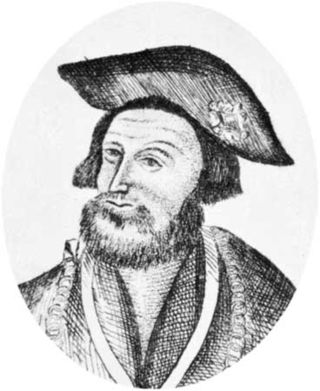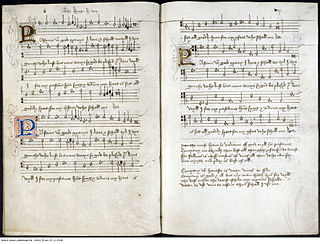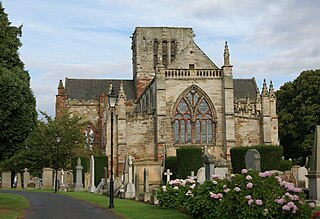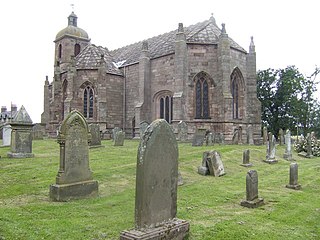Related Research Articles

Sir Thomas de Ercildoun, better remembered as Thomas the Rhymer, also known as Thomas Learmont or True Thomas, was a Scottish laird and reputed prophet from Earlston in the Borders. Thomas' gift of prophecy is linked to his poetic ability.

Mary of Guise, also called Mary of Lorraine, was Queen of Scotland from 1538 until 1542, as the second wife of King James V. She was a French noblewoman of the House of Guise, a cadet branch of the House of Lorraine and one of the most powerful families in France. As the mother of Mary, Queen of Scots, she was a key figure in the political and religious upheaval that marked mid-16th-century Scotland, ruling the kingdom as queen regent on behalf of her daughter from 1554 until her death in 1560.

TamLin is a character in a legendary ballad originating from the Scottish Borders. It is also associated with a reel of the same name, also known as the Glasgow Reel. The story revolves around the rescue of Tam Lin by his true love from the Queen of the Fairies. The motif of winning a person by holding him through all forms of transformation is found throughout Europe in folktales.

Sir David Lyndsay of the Mount was a Scottish knight, poet, and herald who gained the highest heraldic office of Lyon King of Arms. He remains a well regarded poet whose works reflect the spirit of the Renaissance, specifically as a makar.

The Battle of Pinkie, also known as the Battle of Pinkie Cleugh, took place on 10 September 1547 on the banks of the River Esk near Musselburgh, Scotland. The last pitched battle between Scotland and England before the Union of the Crowns, it was part of the conflict known as the Rough Wooing and is considered to have been the first modern battle in the British Isles. It was a catastrophic defeat for Scotland, where it became known as "Black Saturday". A highly detailed and illustrated English account of the battle and campaign authored by an eyewitness William Patten was published in London as propaganda four months after the battle.

The Union of the Crowns was the accession of James VI of Scotland to the throne of the Kingdom of England as James I and the practical unification of some functions of the two separate realms under a single individual on 24 March 1603. Whilst a misnomer, therefore, what is popularly known as "The Union of the Crowns" followed the death of James's cousin, Elizabeth I of England, the last monarch of the Tudor dynasty.
"Frog Went a-Courtin'" is an English-language folk song. Its first known appearance is in Wedderburn's Complaynt of Scotland (1549) under the name "The Frog cam to the Myl dur", though this is in Scots rather than English. There is a reference in the London Company of Stationers' Register of 1580 to "A Moste Strange Weddinge of the Frogge and the Mouse." There are many texts of the ballad; however the oldest known musical version is found in Thomas Ravenscroft's Melismata in 1611.

Sir William Kirkcaldy of Grange was a Scottish politician and soldier who fought for the Scottish Reformation. He ended his career holding Edinburgh castle on behalf of Mary, Queen of Scots and was hanged at the conclusion of a long siege.
"Captain Wedderburn's Courtship" is an old Scottish ballad dating from 1785 or earlier. It is Child Ballad #46, Roud 36. It is known by a number of titles, including "Lord Roslin's Daughter" and "The Laird of Rosslyn's Daughter".

A Satire of the Three Estates, is a satirical morality play in Middle Scots, written by makar Sir David Lyndsay. The complete play was first performed outside in the playing field at Cupar, Fife in June 1552 during the Midsummer holiday, where the action took place under Castle Hill. It was subsequently performed in Edinburgh, also outdoors, in 1554. The full text was first printed in 1602 and extracts were copied into the Bannatyne Manuscript. The Satire is an attack on the Three Estates represented in the Parliament of Scotland – the clergy, lords and burgh representatives, symbolised by the characters Spiritualitie, Temporalitie and Merchant. The clergy come in for the strongest criticism. The work portrays the social tensions present at this pivotal moment in Scottish history.

"Pastime with Good Company", also known as "The King's Ballad", is an English folk song written by King Henry VIII in the beginning of the 16th century, shortly after his coronation. It is regarded as the most famous of his compositions, and it became a popular song in England and other European countries during the Renaissance. It is thought to have been written for Catherine of Aragon.

The sieges of Haddington were a series of sieges staged at the Royal Burgh of Haddington, East Lothian, Scotland, as part of the War of the Rough Wooing, one of the last Anglo-Scottish Wars. Following Regent Arran's defeat at the battle of Pinkie Cleugh on Saturday 10 September 1547, he captured the town of Haddington. The intention was to form a network of mutually supporting English forts in lowland Scotland. The English forces built artillery fortifications and were able to withstand an assault by the besieging French and Scots troops supported by heavy cannon in July 1548. Although the siege was scaled down after this unsuccessful attempt, the English garrison abandoned the town on 19 September 1549, after attrition by Scottish raids at night, sickness, and changing political circumstance.
Queen of Elphame or "Elf-hame", in the folklore belief of Lowland Scotland and Northern England, designates the elfin queen of Faerie, mentioned in Scottish witch trials. In ballads and contemporary texts, she is referred to as Queen of Elphane, Elphen, or the Fairies. She is equivalent to the Queen of Fairy who rules Faërie or Fairyland. The character as described in witch trials has many parallels with the legends of Thomas the Rhymer and Tam Lin.
Robert Wedderburn, the third son of James Wedderburn and Janet Barrie, was born in Dundee, and attended St Andrews University. Having entered St Leonard's College in 1526 he graduated BA in 1529 and MA in 1530, with his name listed at the head of the roll of graduates. In 1528 he was granted the reversion of St Katherine's Chapel in Dundee, despite being under age.
John Wedderburn was a Scottish poet and theologian.

The Rough Wooing, also known as the Eight Years' War, was part of the Anglo-Scottish Wars of the 16th century. Following its break with the Catholic Church, England attacked Scotland, partly to break the Auld Alliance and prevent Scotland being used as a springboard for future invasion by France, partly to weaken Scotland, and partly to force the Scottish Parliament to confirm the existing marriage alliance between Mary, Queen of Scots, and the English heir apparent Edward, son of King Henry VIII, under the terms of the Treaty of Greenwich of July 1543. An invasion of France was also contemplated. Henry declared war in an attempt to force the Scottish Parliament to agree to the planned marriage between Edward, who was six years old at the start of the war, and the infant queen, thereby creating a new alliance between Scotland and England. Upon Edward's accession to the throne in 1547 at the age of nine, the war continued for a time under the direction of the Duke of Somerset, before Somerset's removal from power in 1549 and replacement by the Duke of Northumberland, who wished for a less costly foreign policy than his predecessor. It was the last major conflict between Scotland and England before the Union of the Crowns in 1603.
William Lamb, or William Paniter alias Lamb, was a Scottish cleric, lawyer, and author.
William Stewart was a Scottish poet working in the first half of the 16th century.

Music in early modern Scotland includes all forms of musical production in Scotland between the early sixteenth century and the mid-eighteenth century. In this period the court followed the European trend for instrumental accompaniment and playing. Scottish monarchs of the sixteenth century were patrons of religious and secular music, and some were accomplished musicians. In the sixteenth century the playing of a musical instrument and singing became an expected accomplishment of noble men and women. The departure of James VI to rule in London at the Union of Crowns in 1603, meant that the Chapel Royal, Stirling Castle largely fell into disrepair and the major source of patronage was removed from the country. Important composers of the early sixteenth century included Robert Carver and David Peebles. The Lutheranism of the early Reformation was sympathetic to the incorporation of Catholic musical traditions and vernacular songs into worship, exemplified by The Gude and Godlie Ballatis (1567). However, the Calvinism that came to dominate Scottish Protestantism led to the closure of song schools, disbanding of choirs, removal of organs and the destruction of music books and manuscripts. An emphasis was placed on the Psalms, resulting in the production of a series of Psalters and the creation of a tradition of unaccompanied singing.

Thomas Peebles or Peblis was a Scottish glazier who worked for James IV, Margaret Tudor, and James V of Scotland.
References
- ↑ Marcus Merriman, The Rough Wooings (Tuckwell: East Linton, 2002), pp. 265-201.
- ↑ Lyall, Roderick J., ed. (1985). Ane Resonyng. Aberdeen University Press. ISBN 0-08-030386-2.
- ↑ Notes and Queries, vol. 1 no.26, (27 April 1850), p. 422
- ↑ Stewart, A. M., ed. (1979). The Complaynt of Scotland. Edinburgh: Scottish Text Society.
- ↑ Betteridge, Robert (Winter 2010). "Tracing 'a notoriously difficult title to acquire'". Discover. Edinburgh: National Library of Scotland. 17: 12.
- ↑ Stewart, A. M. (1979) pp. xxi-xxiv.
- ↑ James A. H. Murray, The Complaynt of Scotlande (London, 1872), p. 2.
- ↑ James A. H. Murray, The Complaynt of Scotlande (London, 1872), pp. 3-4.
- ↑ Complaynt, EETS (1872), pp. 68–70
- ↑ "Chapter 10". The Complaynt of Scotlande (1549). EETS. 1872. pp. 84–85.
- ↑ Murray, James A. H., ed (1872). The Complaynt of Scotland (1549). London: Early English Text Society. pp. 40–42.
{{cite book}}:|author=has generic name (help)CS1 maint: multiple names: authors list (link)